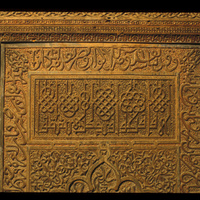Cenotaph? (Panel) of 1300-1400 from Central Asia, Uzbekistan
Item
Title
en
Cenotaph? (Panel) of 1300-1400 from Central Asia, Uzbekistan
Alternative Title
de
Kenotaph? (Paneel) von 1300 -1400 aus Mittelasien, Usbekistan
Type
en
Cenotaph? (Panel)
de
Kenotaph? (Paneel)
Region/Place of Production and Building
Mittelasien
Usbekistan
[Place of Production not identified]
[Building not identified]
Last Location
London
Ownership and Custodial History
Victoria & Albert Museum, Inv.Nr. 1437-1902
Date of Inspection
2000-10
Description
de
Das Paneel weist eine Dreiteilung auf: zwei querrechteckige Felder rahmen das zentrale, große Mittelfeld, dessen Dekor eine Kombination aus geometrischen und vegetabilen Motiven darstellt. Der geometrische Dekor besteht aus sich schneidenden 12-eckigen Polygonen, deren Zentrum je ein sechs-strahliger Stern - umgeben von Hexagonen (6SH6) - bildet. Zwei der vier Dodekaeder sind angeschnitten, der obere läuft aus in das abschließende 5-Pass-Motiv.
en
The panel is divided into three parts: two transverse rectangular fields frame the large central field, whose decoration represents a combination of geometric and vegetal motifs. The geometric decoration consists of intersecting 12-sided polygons, each centered by a six-pointed star surrounded by hexagons (6SH6). Two of the four dodecahedrons are truncated, and the upper one ends in the concluding 5-pointed motif.
In Museum
de
Die Holzarbeit weist Bezüge zu verschiedenen Holzarbeiten auf: ein ähnliches Paneel findet sich am fragmentarisch erhaltenen Kenotaph des Saif ad-Din Bakharzi in Buchara (in der Datenbank), während die östliche Tür zum ziyarat-khaneh des Qutham b. Abbas Komplexes in Samarkand (in der Datenbank) im oberen Bereich ein fast identisches Inschriftpaneel aufweist. Das Ornament des Hauptfeld des Paneels - sich schneidende 12-ecke - ist auf einem Holzfragment belegt, das bei Christie's London am 16.4.86 aufgerufen wurde.
en
The woodwork bears references to various other woodworks: a similar panel is found on the fragmentarily preserved cenotaph of Saif ad-Din Bakharzi in Bukhara (in the database), while the eastern door to the ziyarat-khaneh of the Qutham b. Abbas complex in Samarkand (in the database) features an almost identical inscription panel in its upper section. The ornament of the main field of the panel—intersecting 12-sided figures—is documented on a wood fragment that was auctioned at Christie's London on April 16, 1986.
Inscription / Ornament
de
geometrisch: 6SH6 (Kufi), Inschrift; vegetabil, 12-ecke, Nische
en
geometric: 6SH6 (Kufi), inscription; vegetable, 12-sided forms, niche
Date of Production (Common Era/Hijra)
1300 -1400
Bibliographic Citation
Martin (1926) Taf. *** (o.Text, o.Abb-Legende.)
Christies (1929) pl.XLVII ("carved wooden panel. Bokhara, 16th century")
Bronstein (1938) III, 2625, Anm.1
Is Referenced By
Dimensions
Height: 102 cm
Width: 50 cm
Depth: 3,54 cm
Physical Details
en
wood
de
Walnuß
de
Brettkonstruktion
de
Reste blauer u. roter Farbe
Linked resources
Filter by property
| Title | Alternate label | Class |
|---|---|---|
 Cenotaph of 1336 (before) from Central Asia, Uzbekistan Cenotaph of 1336 (before) from Central Asia, Uzbekistan |
Physical Object |